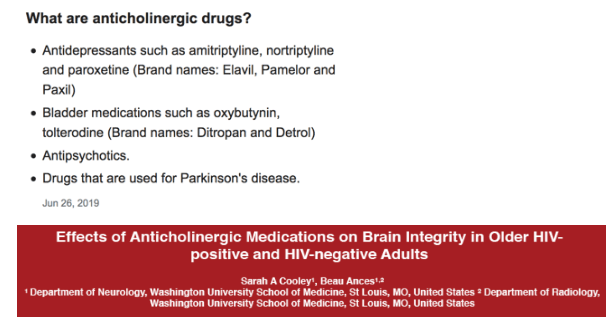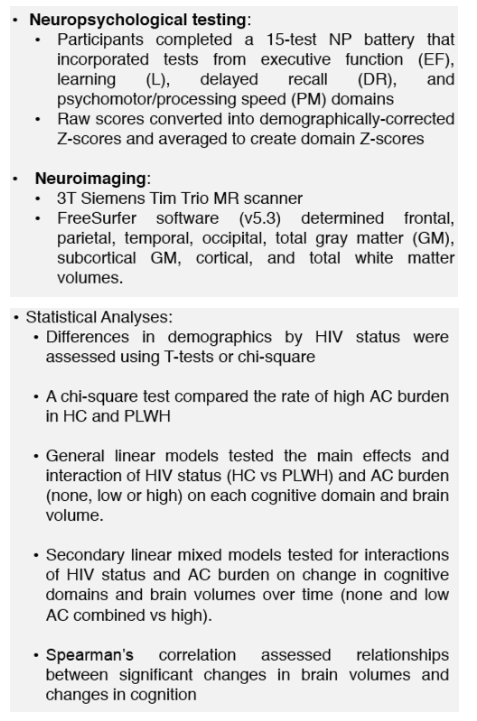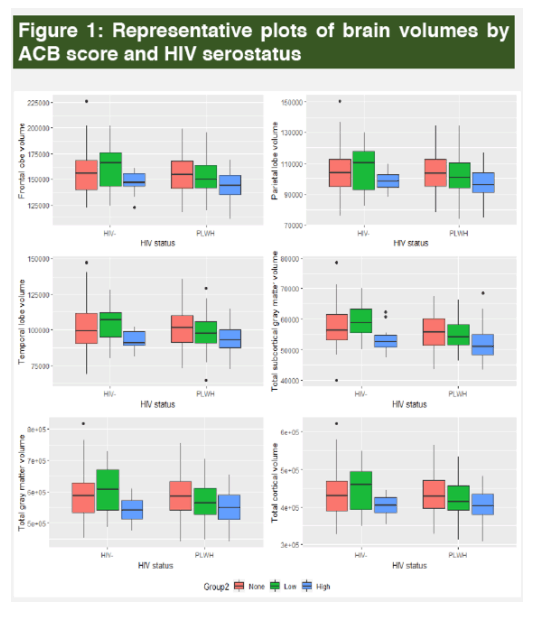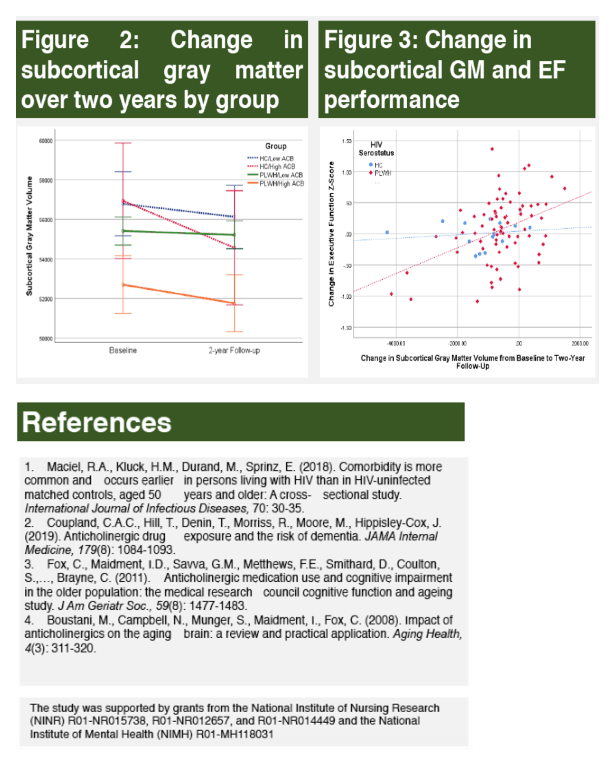 |
 |
 |
| |
EFFECT OF ANTICHOLINERGIC MEDICATIONS ON BRAIN INTEGRITY IN OLDER HIV-POSITIVE ADULTS
|
| |
| |
The aging population of people living with human immunodeficiency virus (HIV) (PLWH) has resulted in an increase in comorbidities requiring medications. While anticholinergic (AC) medications are sometimes prescribed to older adults for a limited period of time, they have been linked to a greater risk of cognitive impairment in the HIV- population. We compared AC burden between older (age ≥50 years) PLWH and HIV- controls (HC) and assessed the interaction of HIV status and AC burden on neuropsychological performance (NP) and brain volumes cross-sectionally and longitudinally at two-year follow-up.
PLWH had a greater proportion of individuals with high ACB [Anticholinergic Cognitive Burden Scale] compared to Healthy Controls, HIV-. Overall, PLWH had significantly worse Neurologic Performance and greater reductions in brain volumes compared to HC (p <.001). Individuals with a higher ACB had worse NP [neuropsychological performance ]and greater reductions in brain volumes compared to individuals who had a low ACB…...No significant interactions were observed between HIV status and ACB (p >.05).
While anticholinergic (AC) medications include - Antidepressants such as amitriptyline, nortriptyline and paroxetine (Brand names: Elavil, Pamelor and Paxil)
Antidepressants
• amitriptyline.
• amoxapine.
• clomipramine (Anafranil)
• desipramine (Norpramin)
• doxepin.
• imipramine (Tofranil, Tofranil-PM)
• nortriptyline (Pamelor)
paroxetine (Brisdelle, Paxil, Paxil CR, Pexeva)
Sarah A.Cooley1, Beau Ances1
1Washington University in St Louis, St Louis, MO, USA
Background:The aging population of people living with human immunodeficiency virus (HIV) (PLWH) has resulted in an increase in comorbidities requiring medications. While anticholinergic (AC) medications are sometimes prescribed to older adults for a limited period of time, they have been linked to a greater risk of cognitive impairment in the HIV- population. The effect of AC in older PLWH with regards to brain volumetrics has not yet been well-established. We compared AC burden between older (age ≥50 years) PLWH and HIV- controls (HC) and assessed the interaction of HIV status and AC burden on neuropsychological performance (NP) and brain volumes cross-sectionally and longitudinally at two-year follow-up.
Methods: The Anticholinergic Cognitive Burden Scale (ACB; Boustani et al., 2008) was used to categorize 105 HC and 215 PLWH with undetectable viral load (<50 copies/mL) aged ≥50 years as low (ACB score ≤3) or high AC burden (ACB score >3). NP (learning/memory, executive function (EF), psychomotor speed (PM)) and brain volumetrics were acquired. A chi-square test compared rates of high AC burden in HC and PLWH. General linear models examined main effects and interactions of HIV status and ACB group on NP and within the frontal, parietal, temporal, occipital lobes; cortical, subcortical, and total gray matter (GM); and total white matter volumes. Linear mixed models examined change in NP and volumes over two years for a subset of 30 HC and 94 PLWH who had no change in AC burden.
Results: PLWH (n=53; 25%) had a greater proportion of individuals with high ACB compared to HC (n=13; 12%) (p=0.01). Overall, PLWH had significantly worse NP and greater reductions in brain volumes compared to HC (p <.001). Individuals with a higher ACB had worse NP and greater reductions in brain volumes compared to individuals who had a low ACB. No significant interactions were observed between HIV status and ACB (p >.05). Longitudinally, both HC and PLWH who had a higher ACB displayed a greater decline in subcortical GM volume over time compared to individuals with low ACB (Figure 1). The observed decline in brain volumetrics significantly correlated with worse PM over time.
Conclusion: The significant effect of higher ACB on NP and GM volumes in older adults (regardless of HIV status) supports concerns over their continued use in older individuals. Although both HIV and high ACB are associated with worse NP and reductions in brain volumetric, no interaction was observed.

Background:The aging population of people living with human immunodeficiency virus (HIV) (PLWH) has resulted in an increase in comorbidities requiring medications. While anticholinergic (AC) medications are sometimes prescribed to older adults for a limited period of time, they have been linked to a greater risk of cognitive impairment in the HIV- population. The effect of AC in older PLWH with regards to brain volumetrics has not yet been well-established. We compared AC burden between older (age ≥50 years) PLWH and HIV- controls (HC) and assessed the interaction of HIV status and AC burden on neuropsychological performance (NP) and brain volumes cross-sectionally and longitudinally at two-year follow-up.
Methods: The Anticholinergic Cognitive Burden Scale (ACB; Boustani et al., 2008) was used to categorize 105 HC and 215 PLWH with undetectable viral load (<50 copies/mL) aged ≥50 years as low (ACB score ≤3) or high AC burden (ACB score >3). NP (learning/memory, executive function (EF), psychomotor speed (PM)) and brain volumetrics were acquired. A chi-square test compared rates of high AC burden in HC and PLWH. General linear models examined main effects and interactions of HIV status and ACB group on NP and within the frontal, parietal, temporal, occipital lobes; cortical, subcortical, and total gray matter (GM); and total white matter volumes. Linear mixed models examined change in NP and volumes over two years for a subset of 30 HC and 94 PLWH who had no change in AC burden.
Results: PLWH (n=53; 25%) had a greater proportion of individuals with high ACB compared to HC (n=13; 12%) (p=0.01). Overall, PLWH had significantly worse NP and greater reductions in brain volumes compared to HC (p <.001). Individuals with a higher ACB had worse NP and greater reductions in brain volumes compared to individuals who had a low ACB. No significant interactions were observed between HIV status and ACB (p >.05). Longitudinally, both HC and PLWH who had a higher ACB displayed a greater decline in subcortical GM volume over time compared to individuals with low ACB (Figure 1). The observed decline in brain volumetrics significantly correlated with worse PM over time.
Conclusion: The significant effect of higher ACB on NP and GM volumes in older adults (regardless of HIV status) supports concerns over their continued use in older individuals. Although both HIV and high ACB are associated with worse NP and reductions in brain volumetric, no interaction was observed.







|
| |
|
 |
 |
|
|